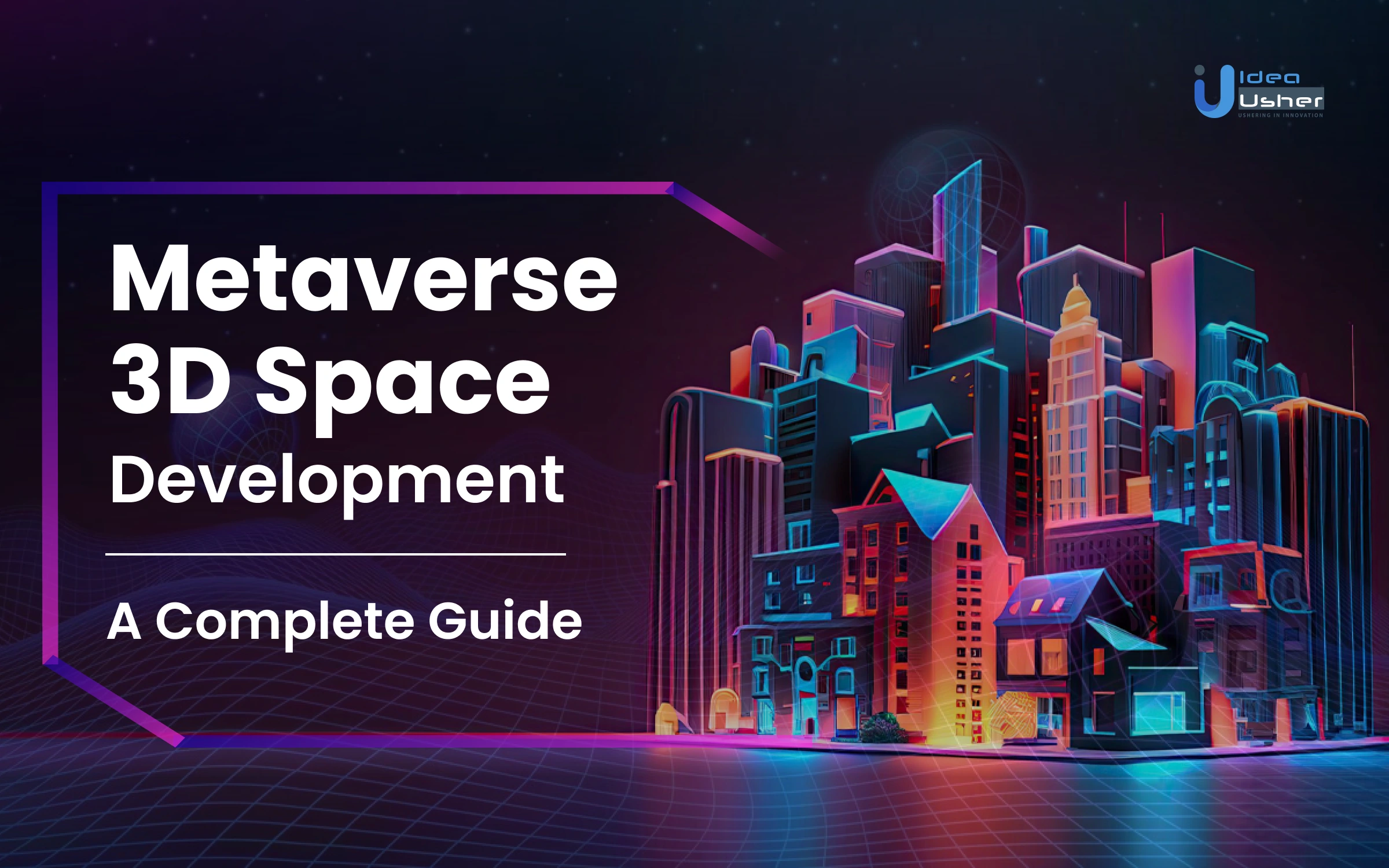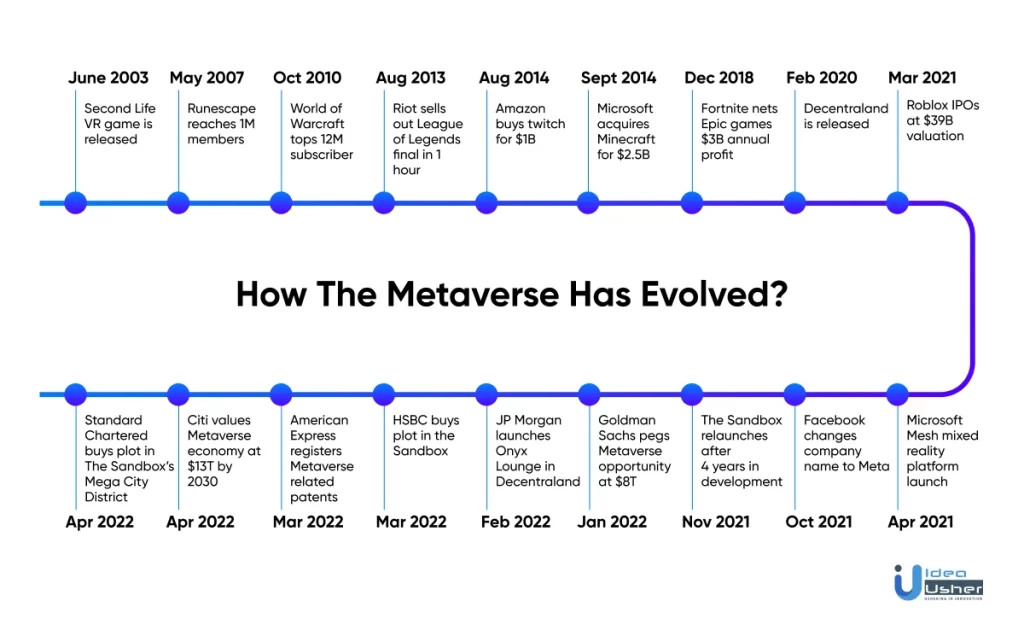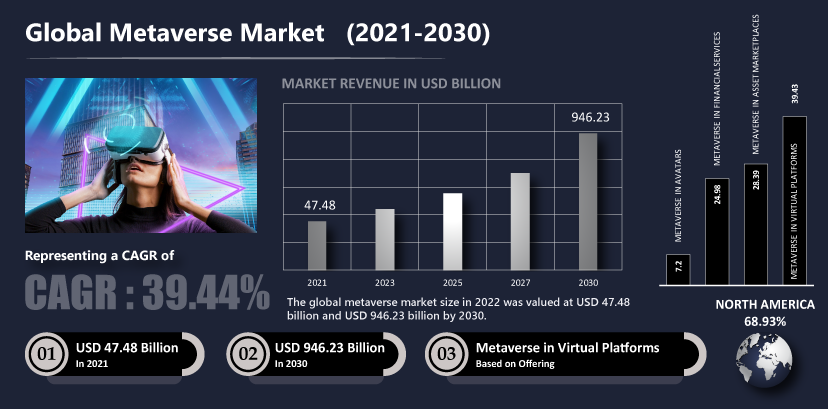
The Metaverse, a shared 3D online realm where users interact with each other and digital elements, is revolutionizing the way we experience the virtual world. As it continues to expand, it presents a wealth of opportunities for content creators, developers, and entrepreneurs to delve into the domain of 3D space development. With the Metaverse market projected to surge to an estimated $800 billion by 2024, the possibilities it offers are boundless. In this blog, we will explore the intricacies of Metaverse 3D space development costs influenced by various factors, development processes, and required basic elements. We’ll also delve into the technical and strategic facets of this captivating domain, making this blog a valuable resource for anyone seeking to explore or enhance their presence in this digital wonderland.
- The Metaverse
- Metaverse In 2023 And Beyond
- What Is Metaverse 3D Space?
- The Cost Of Building 3D Spaces In The Metaverse
- Key Elements Of Metaverse 3D Space
- Key Characteristics Of Metaverse 3D Space Development
- How To Develop 3D Spaces In The Metaverse For C-Suite Executives
- Top 10 Companies Investing In Metaverse 3D Space In 2023
- The Evolution And Future Of The Metaverse
- How Can Idea Usher Help?
- FAQ
The Metaverse
The term Metaverse stands for the next step in the internet’s development. It’s a virtual shared space created by merging our physical and digital worlds. It’s a three-dimensional online environment where users, represented by avatars, interact with each other in digital spaces separated from the real world. This digital world falls under Extended Reality (XR), encompassing Augmented Reality (AR), Virtual Reality (VR), and Mixed Reality (MR).
AR enhances the real world with digital elements, like overlaying information. VR immerses users in a fully virtual environment, typically used for gaming and entertainment, forming the foundation for the Metaverse. MR merges AR and VR, anchoring digital objects in the real world for interactive experiences.
Emerging concepts like Cross Reality blur the lines between physical and digital spaces. Understanding these distinctions is crucial for assessing the cost of developing 3D spaces in the Metaverse.
Impact of Metaverse on Different Industries in 2023
1. Urban Planning
In 2023, the Metaverse is set to play a significant role in urban planning. Urban planners can now use this virtual space to test their proposed changes before implementing them in the real world.
2. Gaming
The gaming industry has already seen substantial changes. Concepts from the Metaverse, like 3D avatars and virtual world building, are present in popular games like SimCity, Minecraft, and Second Life.
3. Media and Entertainment
The Metaverse is not just about technology; it’s a new way to create and enjoy media content. It transcends physical boundaries and allows people to connect, tell stories, and share experiences.
4. Retail, Fashion, and Apparel
These industries were early adopters, but now many companies in technology, telecommunications, automotive and healthcare sectors are also getting involved in the Metaverse.
Metaverse In 2023 And Beyond
In 2023, one can expect a notable surge in virtual Metaverse events, featuring interactive fairs and booths that facilitate global networking. The Metaverse is set to grow into an $800 billion industry by 2024, with a particular focus on live events and advertising.
Notably, the “Value creation in the Metaverse” report from McKinsey in 2022 revealed that an astounding sum exceeding $120 billion was invested in Metaverse-related projects during the initial five months of a specific year, underlining the remarkable interest and investment in this virtual space.
J.P. Morgan’s forward-looking perspective is equally striking, envisioning the Metaverse as a massive market opportunity estimated at a staggering $1 trillion. This visionary outlook underscores the expansive potential within the virtual industry, especially in the year 2023, as the Metaverse market gears up for substantial growth.
Drawing from insights provided by a Gartner report, it is estimated that around 25% of individuals are expected to allocate at least one hour each day to activities within the Metaverse. These activities encompass work, shopping, education, social networking, and entertainment. Additionally, a study conducted by PwC sheds light on the remarkable efficiency of Virtual Reality (VR) simulations for training. This study reveals that individuals trained through VR simulations acquire knowledge at a rate four times faster than their classroom counterparts and twice as fast as e-learners.
The Metaverse’s transformation into an industry of considerable scale, with a projected market value of $800 billion by 2024, is set to revolve around the spheres of live events and advertising, thereby encouraging enterprises to deepen their involvement in the Metaverse as this virtual realm continues to expand and evolve.
Why Should Businesses Invest in Metaverse Development?
Businesses should prioritize Metaverse development for several technical reasons. Firstly, the Metaverse offers an innovative platform for immersive customer engagement. This virtual space enables businesses to create interactive and personalized experiences, fostering stronger connections with customers.
Secondly, the Metaverse can enhance remote work and collaboration. With a virtual workspace, businesses can bring together teams and partners from around the world, increasing productivity and streamlining communication.
Furthermore, the Metaverse presents opportunities for cost-effective training and simulations. It allows businesses to employ Virtual Reality (VR) and Augmented Reality (AR) technologies for employee training, reducing the need for physical resources and enhancing learning outcomes.
In addition, the Metaverse offers a novel advertising medium. Businesses can leverage this space for creative and immersive advertising campaigns, reaching a global audience in a unique way.
Finally, the potential for data and analytics in the Metaverse is significant. Businesses can gather valuable insights about user behavior, preferences, and interactions, enabling data-driven decision-making and improving product or service offerings.
What Is Metaverse 3D Space?
A Metaverse 3D environment is a digital expanse that facilitates three-dimensional interaction between users and their virtual surroundings. This immersive space can be accessed through an array of devices, including computers, smartphones, and virtual reality headsets. Within the Metaverse 3D space, a diverse range of activities takes place, encompassing gaming, social networking, NFT marketplaces, event hosting, real estate ventures, art galleries, and exhibition halls.
The Cost Of Building 3D Spaces In The Metaverse
Developing 3D spaces within the Metaverse is a complex endeavor influenced by various critical factors. Assessing the cost of such development includes identifying many considerations:
1. Cost Range
Making Metaverse spaces can cost a lot or a little, depending on what you want to do. It might be as low as a few bucks or go up to many thousands. Typically, it falls somewhere in the middle, based on what you’re trying to achieve.
2. Financial Perspective
The Metaverse is a promising place for business. It could be worth trillions in spending. The NFT market, which is part of the Metaverse, is expected to get much bigger. Right now, the Metaverse market is worth a lot.
3. Budget Influencers
Many things can affect how much you’ll spend. Using fancy technology like augmented reality, virtual reality, cryptocurrency, and more can increase costs. The devices you need to make the Metaverse work also impact the budget. Infrastructure, or the stuff that makes it all run smoothly, is another part of the cost. How interactive, detailed, and fun your Metaverse is will also change the price.
Key Elements Of Metaverse 3D Space
Metaverse 3D spaces are crafted using a set of fundamental elements that define their unique nature and immersive capabilities. These elements include:
1. Three-Dimensional Design
Metaverse 3D spaces are inherently three-dimensional, simulating real-world environments in a digital realm. This dimensionality creates a lifelike atmosphere within the virtual world, enhancing user experiences.
2. Interconnected, Interactive, and Immersive 3D Worlds
The Metaverse thrives on interconnected, interactive, and immersive 3D worlds. These spaces are not isolated; they link seamlessly, allowing users to explore, interact, and engage with others. This interconnectedness fosters a sense of presence and shared experiences.
3. Integration of VR and AR Technology
Virtual Reality (VR) and Augmented Reality (AR) technologies play pivotal roles in Metaverse development. VR immerses users in fully virtual environments, while AR augments real-world surroundings with digital elements. These technologies enable users to connect and interact across distances, fostering a sense of togetherness despite physical separation.
4. Real-Time Rendered 3D Virtual Worlds and Environments
The Metaverse is a vast network of real-time rendered 3D virtual worlds and environments. It provides users with synchronous, persistent experiences where they can navigate, socialize, and transact. This continuity extends to various aspects, including identity, history, entitlements, objects, communications, and payments, ensuring a seamless and cohesive virtual existence.
Key Characteristics Of Metaverse 3D Space Development
Metaverse 3D space development stands at the forefront of technological innovation, promising a dynamic virtual realm enriched with remarkable features. Our journey takes us from virtual reality to augmented reality, culminating in the boundless possibilities of the metaverse. Within this landscape, several standout features define the allure of metaverse 3D space development:
1. Persistence
Metaverse 3D spaces are renowned for their unwavering persistence. In contrast to conventional 3D spaces susceptible to constant changes, the metaverse remains steadfast unless deliberate alterations are initiated. This remarkable continuity empowers users to access consistent experiences across various devices and physical locations, fostering a unified brand experience for businesses transcending geographical boundaries.
2. Enhanced Security
Metaverse 3D space development prioritizes robust security measures. Advanced encryption and authentication protocols are employed to safeguard user data, far surpassing the security standards of traditional 3D spaces. This heightened security creates formidable barriers for potential hackers, making the metaverse an ideal choice for businesses committed to protecting sensitive information.
3. Three-Dimensionality
The metaverse’s three-dimensional feature immerses users in a dynamic environment closely resembling the physical world. Within these 3D spaces, users navigate, interact with objects, and engage with fellow users naturally, fostering a rich social experience.
4. Immersion
Customization is key within metaverse 3D spaces, allowing users to tailor their environments to precise specifications. This degree of personalization enhances immersion, affording users a profound sense of ownership over their virtual surroundings.
Metaverse 3D space development ushers in a new era of digital experiences, where persistence, security, three-dimensionality, and immersion converge to redefine the virtual landscape.
How To Develop 3D Spaces In The Metaverse For C-Suite Executives
Developing 3D spaces in the Metaverse is a dynamic and complex process that fuses technological expertise with strategic planning. Here is a comprehensive guide to navigate this exciting realm effectively, incorporating key elements from both datasets:
1. Vision and Objectives
Initiate the process by formulating a clear vision for your Metaverse 3D space. In-depth research and strategic planning are imperative to align your offerings with market demands and user preferences.
2. User Interface (UI) Design
Prioritize the design of an intuitive and engaging user interface (UI) that enhances the user experience. Craft a user-friendly and visually appealing interface to ensure a seamless and captivating experience.
3. Roadmap and Resource Allocation
Create a detailed roadmap that outlines key milestones and achievements for your Metaverse 3D development. Simultaneously, strategically allocate resources, encompassing financial investments and workforce, to support the development journey.
4. Monitoring and Engagement
Regularly monitor the project’s advancement, involving vital stakeholders, including partners and investors. Continuous assessment of performance against established timelines is pivotal to ensure alignment with expectations.
5. Innovation and Adaptation
Embrace innovation and stay informed about evolving user preferences within the dynamic Metaverse landscape. The rapid technological advancements within this space necessitate an unwavering commitment to ongoing innovation and improvement.
6. Smart Contracts Development
Incorporate smart contract development, enabling secure, transparent, and automated transactions within your Metaverse 3D space. NFT marketplaces, gambling platforms, and e-commerce platforms within the Metaverse rely on smart contracts for their functionality.
Additional Key Considerations
- Cross-Platform Compatibility: Ensure your Metaverse spaces are accessible across various devices, enhancing audience reach and engagement.
- Data Security and Privacy: Prioritize robust data security and privacy measures to safeguard user information and maintain trust and compliance.
- Scalability and Flexibility: Design your Metaverse spaces with scalability in mind to accommodate growth and changing user preferences efficiently.
- Content Management: Implement a robust content management system to facilitate easy updates, additions, and maintenance, ensuring the content remains fresh and engaging for users.
Top 10 Companies Investing In Metaverse 3D Space In 2023

Here is the list of the top 10 companies in the metaverse 3D space:
1. Epic Games
The company behind Fortnite is making significant investments in new metaverse gaming projects. In 2022, Epic Games secured $2 billion in funding from Sony and Kirkbi, the parent company of Lego, to develop a kid-friendly metaverse platform. Additionally, they are supporting metaverse infrastructure developer Hadean in their latest $30 million funding round.
2. Roblox
Roblox, a global online gaming platform, is at the forefront of creating metaverse gaming experiences. While it faced some temporary setbacks, analysts view Roblox as an affordable long-term investment in the metaverse space.
3. Unity Technologies
Unity Technologies, a popular global game engine company, empowers developers to create new experiences. They made a significant move in November 2021 by acquiring digital VFX company Weta Digital for over $1.6 billion. This acquisition aims to accelerate the development and deployment of real-time 3D technologies in the metaverse.
4. Shopify
E-commerce and online shopping will undergo a transformation in the metaverse. French Web3 startup Metav.rs, often referred to as the “Shopify of the metaverse,” secured $3 million in seed funding led by Singapore-based Web3 fund Jsquare.
Additionally, in 2021, Shopify forged a partnership with Novel to deliver web3 solutions to users who are building on the Shopify platform. The Novel Shopify app further empowers users to generate and distribute their own NFTs (Non-Fungible Tokens).

5. Google
In January 2022, Google embarked on a substantial journey into the Metaverse, solidifying its reputation as a major investor in Augmented Reality (AR) technologies. This commitment is exemplified by Google’s $39.5 million investment in a private equity fund exclusively dedicated to Metaverse projects. Notably, the company is directing considerable resources toward advancing the Metaverse, with a particular focus on bolstering its Virtual Reality (VR) and AR teams and cultivating a collaborative virtual reality space. Google labels its involvement in the Metaverse as “ambient computing,” signifying its dedication to the development of this emerging digital realm. It’s important to note that this information is based on data available as of 2023, and further updates may occur, making it advisable to stay informed through Google’s official announcements and press releases for the most current and detailed insights.
6. Decentraland
Decentraland operates as a virtual-reality platform and metaverse using the Ethereum blockchain. Users engage in a 3D space known as LAND, a non-fungible digital asset divided into parcels that community members can own and trade using Decentraland’s cryptocurrency, MANA.
7. Meta
Meta’s primary investment focus is on advancing artificial intelligence. The company is undergoing a workforce reduction, emphasizing operational efficiency, and redirecting its capital away from the metaverse. While the metaverse still holds importance for Meta, it won’t be the primary destination for its capital. About 20% of Meta’s expenses will continue to be allocated to Reality Labs in 2023.
8. Microsoft
Microsoft’s Metaverse involvement centers around its Mesh platform, aimed at creating a shared virtual environment. The company has formed a strategic partnership with Meta to develop Mesh. Microsoft’s CEO, Satya Nadella, envisions a diverse metaverse landscape, with no centralization. Supporting multiple metaverse platforms and fostering a rich ecosystem of content, commerce, and applications is their vision.
9. Nvidia
Nvidia is collaborating with Microsoft to provide vast computing resources for Microsoft’s enterprise users in the metaverse and AI domains through cloud-based services. Nvidia’s Omniverse platform serves as a convergence point for 3D environments and digital replicas. Additionally, they are partnering with Adobe on a Substance 3D plugin, enabling Substance Material compatibility within Omniverse.
10. Adobe
Adobe, a specialist in software for creative content creation, has made substantial investments in 3D and immersive technology. Their suite of tools and services, known as Adobe Substance 3D, is dedicated to supporting the creation of 3D content. In October 2022, Adobe unveiled plans to extend its Substance 3D portfolio to Meta’s Quest platform. Notably, Adobe has joined forces with prominent brands such as Coca-Cola Co. (KO), the creators of “Fortnite” – Epic Games, Nvidia, Nasdaq, and others to aid them in crafting unique 3D content and immersive digital experiences. Scott Belsky, Chief Product Officer and Executive Vice President of Adobe Creative Cloud, emphasizes that the success of the metaverse and other immersive experiences hinges on them being rich in features, personalized, engaging, and replete with interactive content.
The Evolution And Future Of The Metaverse

The Metaverse, a concept that has captured our collective imagination, is on a journey with an unpredictable trajectory. Despite the ongoing hype, there are signs that its growth may be less meteoric than initially projected. Tencent’s decision to shelve its VR hardware plans and the lingering ambiguity surrounding the Metaverse’s future have cast a veil of uncertainty over its ultimate destination. Predicting where this digital realm will be a decade from now remains a formidable challenge.
However, amid these uncertainties, one thing is clear – the Metaverse represents an immense, untapped frontier of possibilities. The market size, as per Bloomberg estimates, could reach an astounding $800 billion by 2024, underscoring its undeniable potential.
a. The Current Metaverse
As it stands, the Metaverse comprises blockchain-based digital worlds that users can access through immersive technologies and the Internet. However, it’s essential to view these as the early stages, often referred to as the ‘pre-metaverse.’ They serve as a stepping stone to something more profound.
b. Maturity by 2030
Some experts in the field envision the Metaverse reaching maturity and achieving mainstream adoption by 2030. This milestone is not far off, and it heralds a future where technology will be seamlessly integrated into our daily lives.
c. Key Tech Players
The Metaverse’s journey will be shaped by the technology we use to access it. Virtual reality (VR), augmented reality (AR), and emerging technologies such as brain-computer interfaces (BCI) are the key enablers. Notably, industry giants like Apple, Google, Meta Platforms (formerly Facebook), Microsoft, Niantic, and Valve are actively working on the technological infrastructure that will define the Metaverse of tomorrow.
d. Optimistic Outlook
A report by the Pew Research Center paints an optimistic picture, suggesting that the Metaverse’s rapid evolution will bring benefits to diverse aspects of society. It’s expected to enhance education, healthcare, gaming, the arts, social interactions, and civic life. A significant 54% of surveyed individuals anticipate that by 2040, the Metaverse will have evolved into a sophisticated digital environment, benefiting the lives of approximately half a billion people.
e. Profit-Driven Growth
The research also highlights the pivotal role of profit motives in driving substantial investments in the Metaverse. By 2040, the capability to create fully immersive digital universes is expected to become a reality. This tantalizing prospect is driving interest and funding into the Metaverse from a range of sectors.
f. Real-World Integration
The XR Association, founded by industry giants like Meta, Google, HTC Vive, Microsoft, and Sony Interactive Entertainment, is already witnessing the integration of the Metaverse into various sectors. It’s not limited to gaming and entertainment. Higher education institutions are embracing Metaverse-based teaching, while major corporations, including Walmart, SAP, and Delta, are harnessing the technology for workforce training. Applications extend to areas such as warehousing, product engineering, job training, upskilling, and even virtual healthcare patient monitoring.
The Metaverse, as it continues to evolve, promises to redefine our digital landscape and profoundly impact various facets of our lives. The path ahead is dynamic and promising, with the potential to reshape how we interact with technology and each other in this burgeoning digital realm. While its ultimate destination remains uncertain, its journey is one of the most exciting and transformative chapters in the digital age.
How Can Idea Usher Help?
At Idea Usher, we specialize in Metaverse-related projects, potentially serving as a game-changer for your business growth. With an impressive track record of leading the technological revolution for nearly a decade, we possess the expertise and experience necessary to reshape your digital landscape.
Our extensive team, combined with our experience of successfully executed projects, stands as a testament to our capabilities in handling projects of all scales. Whether you are a small enterprise seeking to venture into the Metaverse or a large corporation with ambitious 3D space development requirements, we boast the skills and resources to fulfill your needs.
Our prior collaborations with world-leading clients underscore our unwavering commitment to excellence. By partnering with Idea Usher, you can tap into our wealth of knowledge and resources to drive your Metaverse projects towards success. We are your trusted ally on the journey to harness the vast potential of the Metaverse and propel your business growth. Reach out to us today to commence a conversation about your unique requirements.
Hire ex-FANG developers, with combined 50000+ coding hours experience




Contact Idea Usher at [email protected]
FAQ
Q. What is Metaverse 3D space development?
Metaverse 3D space development encompasses the intricate process of crafting a shared, internet-based 3D realm. Within this realm, users engage with both each other and computer-generated elements, including avatars and objects. This virtual universe operates over the Internet, forging a unique digital ecosystem.
Q. What are the main features of 3D spaces in Metaverse?
The 3D spaces within the Metaverse are distinguished by their three-dimensional nature, immersion, and persistence. These digital environments are meticulously designed to replicate real-world scenarios, whether they serve as gaming landscapes, marketplaces, or social hubs.
Q. What are some examples of Metaverse-based NFT marketplaces?
Decentraland and Axie Infinity stand out as prime examples of NFT marketplaces in the Metaverse. These platforms facilitate interactive experiences by enabling the tokenization, trading, and monetization of digital assets within the virtual realm.
Q. Which companies are developing the tech that will shape the future of the Metaverse?
Prominent tech giants, including Apple, Google, Meta Platforms (formerly Facebook), Microsoft, Niantic, and Valve, are at the forefront of developing the technologies that will define the future of the Metaverse.
Related posts:
- What Are Metaverse Avatars | Development Guide
- Metaverse Shopping Mall Development: A Complete Guide
- What is Metaverse | A Deeper Insight
- The Ultimate Checklist for Metaverse Game Development
- TOP USE CASES OF METAVERSE IN 2023
- Metaverse Healthcare Development: A Complete Guide
Powered by YARPP.
Rebecca is a multi-disciplinary professional, proficient in the fields of engineering, literature, and art, through which she articulates her thoughts and ideas. Her intellectual curiosity is captivated by the realms of psychology, technology, and mythology, as she strives to unveil the boundless potential for knowledge acquisition. Her unwavering dedication lies in facilitating readers' access to her extensive repertoire of information, ensuring the utmost ease and simplicity in their quest for enlightenment.
Hire the best developers
100% developer skill guarantee or your money back. Trusted by 500+ brands

Contact Us
- SCF 98, Phase 11, Sector-67 Mohali, 160062
- 651 B Broad St, Middletown, 19709, county New Castle Delaware, USA
- [email protected]
- (+1) 628 432 4305
HR contact details
Follow us on

Idea Usher is a pioneering IT company with a definite set of services and solutions. We aim at providing impeccable services to our clients and establishing a reliable relationship.
Our Partners
Contact Us
- SCF 98, Phase 11, Sector-67 Mohali, 160062
- 651 B Broad St, Middletown, 19709, county New Castle Delaware, USA
Follow us on

Idea Usher is a pioneering IT company with a definite set of services and solutions. We aim at providing impeccable services to our clients and establishing a reliable relationship.





Rebecca Lal